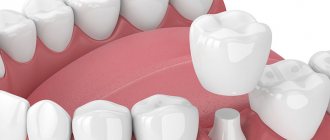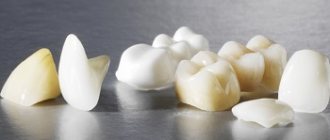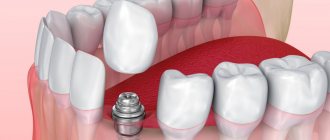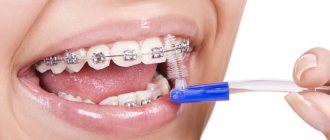Features of a temporary crown on an implant
After implantation, a certain period of time must pass before the permanent crown is placed. Over the course of several months, a specialist monitors the osseointegration of the titanium screw. But walking even for several days with a “space” instead of a tooth is extremely uncomfortable. A temporary crown on an implant made of composite material or plastic will help solve the problem. The design does not interfere with the process of engraftment of the artificial root and creates the necessary load for primary stabilization. Due to the fact that special cement dissolves over time under the influence of salivary enzymes, the temporary crown can easily be replaced with a permanent one at the right time.
What are temporary crowns on implants used for?
In addition to maintaining the aesthetics of your smile, temporary crowns placed on titanium roots perform a number of other useful tasks.
- Preparation of soft tissues for the next stage of implantation.
- Providing psychological comfort.
- Helps in the formation of smooth gum edges.
- Protection against bacteria that can cause gum inflammation and implant rejection.
- Maintaining correct diction and bite.
- Restoration of chewing functions.
- Facilitate adaptation to permanent crowns.
- Creating the correct load to stabilize the implant.
Shaping the gum contour using temporary crowns
With one-stage dental implantation, when a tooth is removed and an implant is immediately installed in its place, a temporary crown (if it can be installed immediately) allows you to preserve the natural contour of the gum around the tooth, preventing the gum from filling the tooth socket.
If it was not possible to immediately install a temporary crown on a dental implant, and the gums have leveled out during the healing of the implant, then temporary crowns help form the correct gingival contour. Let's take a closer look at how this happens.
After the implants have healed, gum formers are screwed into them, which allow access to the implant to be created (sometimes gum formers are installed at the time of dental implantation).
Result after removal of the gum former:
The crown in the lower part has the shape of a cone, so with a special drill or laser the hole from above is expanded to give it a cone-shaped shape, like natural teeth. The expansion is performed under local anesthesia. The advantage of using a laser is that the vessels are immediately sealed and this operation is practically bloodless.
Temporary crowns for implants are made by an orthopedic dentist on the day of the patient’s visit using wax models prepared in advance in the laboratory. A temporary abutment (crown base) is screwed into the implant, and temporary crowns are fixed onto the abutment using temporary cement.
While wearing temporary crowns (about 2 weeks), the gums heal and finally take the desired shape, not only around the crown, but also filling the interdental space (gingival papillae are formed).
Temporary crowns are easily removed, since the fixing composition is not strong (this was done specifically so that the temporary crown can be removed without damaging the implant). If the crown falls off ahead of time, then it must be fixed in place as quickly as possible so as not to disturb the healing of the gums.
Having removed the temporary crowns after 2 weeks, the doctor sees a well-formed bed:
Impressions can now be taken to make permanent crowns that will look perfect from all angles.
While the permanent crowns are being manufactured, temporary crowns are re-installed on the implants.
After the permanent abutments and crowns are made, the temporary structures are removed and the permanent crowns are fixed onto the implants. Thanks to the preparation of the gums, permanent crowns look absolutely natural from all sides.
Without preliminary preparation of the gums, black triangles remain between the teeth, and food gets clogged between the teeth.
Thus, temporary crowns are necessary to create tight contact between the gum and the crown on the implant, which ensures not only aesthetics, but also the health of the gums and the ease of use of the crowns.
Abutment for an implant - what is it and why is it needed?
The article is commented on by orthopedic dentist Artem Vladimirovich Vasilkov.
The abutment connects the implant and the denture and serves as a support for the orthopedic structure. There is a special hole inside the implant where the lower part of the abutment is built in. The upper one replaces the tooth ground for a crown.
What does an abutment in dentistry consist of?
Titanium
The titanium abutment is characterized by maximum reliability: it is very strong and durable. But due to the dark shade of the metal, it can shine through the crown. Titanium abutments are suitable for chewing teeth that are not visible when smiling. Also, an aesthetic defect will not appear if prostheses made of opaque material, for example, metal ceramics, are used.
Zirconium dioxide
Zirconium abutments are used in the smile area for maximum aesthetics. They are white, the same as the natural tooth and ceramic crown. A zirconium dioxide abutment is durable and aesthetic, but its cost is higher than that of titanium.
Combined
Abutments made of titanium and zirconium alloy combine the advantages of the two previous options. They are distinguished by good functional and aesthetic qualities and a long service life. Manufacturing companies rarely offer such material, so combined abutments are often made in the laboratory to order, individually for a given patient.
“In most cases, I recommend to patients a combined abutment: made of white zirconium, but with the strongest titanium base. The base is fixed inside the implant, deep under the gum, so a long service life is more important to us than matching the color,” explains Vasilkov A.V.
Alloy of cobalt and chromium
Outdated option: inferior in strength and aesthetics, more often causes allergies or a metallic taste in the mouth. The cost is slightly cheaper than titanium, so it is not recommended even for reasons of economy.
Plastic
Option for temporary structures only. With a plastic crown, you get an inexpensive temporary tooth that will restore the aesthetics of your smile while the implant heals. A more durable option is a titanium or combined abutment and a plastic crown. Some careful patients wear a temporary structure for 1-2 years before it needs to be replaced with a permanent option.
Types of abutments
Each implant manufacturer offers entire lines of ready-made abutments for different clinical cases. However, your dentist may suggest that you have a custom abutment made in a laboratory. Which abutment is better to choose?
Standard stamped
The orthopedic dentist determines which abutment is needed in your case: long, narrow, angled, double, etc. Next, the doctor orders a standard version from the catalog provided by the manufacturer of your implant system.
Pros:
- Models have been developed for most clinical situations.
- If it breaks, it’s easy to replace: order the same one and wait for delivery to your city.
- Profitable price.
- Leading manufacturers provide a lifetime warranty on abutments.
Minuses:
- It is impossible to take into account all the features of the dental system of a particular patient.
- The aesthetics of the gums is reduced, and soft tissue correction may be required.
- An imperfect fit of the gums to the dentures will require more attention to hygiene and the prevention of inflammation.
“The standard abutment should be from the same manufacturer as the implant. These elements are specially designed as a single system to fit together in the best possible way, without gaps. Saving by placing a cheap abutment on a good implant is fraught with complications after implantation,” warns A.V. Vasilkov.
Custom abutment
The doctor scans the patient's jaws or an impression taken of them. Next, he creates and adjusts a 3D computer model of the future product. Based on the model, the abutment is machined in the laboratory on a digital machine.
Pros:
- Digital modeling instead of selection by the doctor “by eye”, accuracy up to 2 microns.
- Full compliance with size, shape, slope, etc.
- Quick adaptation, optimal fit of the gums.
- Exact shade match: abutment in the color of the crown.
“A custom abutment is created to be equal in width to the root of the extracted tooth. Nature has already formed the gum contour to this size. The upper part of a standard product is narrow, it has to be restored with a crown, and the fit of the gum will not be tight. A gap will form where food debris and microbes will accumulate,” notes A.V. Vasilkov.
Minuses:
- Higher price
- The warranty period is set by a specific clinic, check it in advance.
Production time – plus or minus?
How long will I have to wait for the abutment to be made during treatment or if it is replaced if it breaks? This depends on whether the clinic has its own dental laboratory and whether it is equipped with a digital milling cutter.
- We have our own digital laboratory: duration from 2 hours.
- The order is transferred to another laboratory: it depends on logistics, workload, terms of the contract, etc. On average 1-2 weeks.
Which abutment should you choose in your case: standard or custom?
“Individual is always better, but in some situations the difference is not significant. Consult your orthopedic dentist: find out how typical your case is and whether the standard option will help solve the problem completely,” recommended Artyom Vladimirovich.
Fixation: abutment on implant
The abutment will be required immediately before fixing the prosthesis. For immediate loading, a temporary abutment is installed on the day of implantation. Later you will need to replace it with a permanent option.
With the classic two-stage implantation method, the abutment will be installed 3-6 months after surgery. During the healing period of the implant, instead of the abutment and prosthesis, the patient wears a special plug, and later - a gum former.
Fixation: prosthesis on abutment
Immediately after installing the abutment, the doctor will place an orthopedic structure on it.
In modern dentistry, several methods of fixing a prosthesis to an abutment are used:
Cement. Durable hypoallergenic dental cement will securely fix the prosthesis and will be completely invisible underneath. Minus: the connection is permanent. If you need to replace the prosthesis or abutment, you will have to saw the structure and change both elements at once. Cement fixation is used for single crowns or in stable situations in the oral cavity.
Screws. Convenient and modern detachable connection. Small screws are screwed through the chewing surface of the tooth. To make the connection unnoticeable, the doctor will disguise the “heads” of the screws with a composite from which dental fillings are made. If necessary, the prosthesis can be removed or its fixation adjusted. This is the best option for patients who have been missing teeth for a long time, have impaired closure and bite, and therefore will require relining of dentures.
Other options. For removable dentures on implants, telescopic or spherical fastenings can be used. Ball-shaped abutments are used more often: the sloping upper element allows the patient to independently remove and put on the prosthesis for hygienic procedures.
“The most modern version of the abutment is made according to your impressions, from zirconium dioxide or its combination with titanium, and the prosthesis is fixed to it with a screw. But each clinical case is individual, so listen to your doctor’s recommendations and choose the best option for you,” advises Artem Vladimirovich.
How long can temporary crowns be worn?
Typically, temporary crowns are worn for no more than 2 months. Temporary crowns are made from plastic or composite polymers. These materials are quite porous and not very durable. Long-term wearing of temporary dental crowns is not recommended due to the strong accumulation of bacteria on the surface of the crown, which causes inflammation of the gums, as well as increased abrasion of the material.
Plastic temporary crowns can change color due to the use of coloring products - tea, coffee, red wine, etc.
Temporary crowns that will be worn for longer than 2 months are made from more durable materials.
Life time.
As has already become clear, this device is intended only for a short period of use and for the purpose of replacing a cosmetic defect and restoring the functionality of the jaw. Typically, plastic products last no more than 6 months, and composite ones up to a year. Therefore, you are unlikely to be able to extend the shelf life of the “caps”, and if you do not follow the operating rules, you risk reducing it altogether. When wearing crowns for a long time, their surface wears off, which is why neighboring healthy teeth begin to shift towards the ground unit, and the aesthetics of artificial systems leaves much to be desired. It is not recommended to delay the next stage of prosthetics, and as soon as the main onlay is ready, replace it.
What to do if the crown falls out.
As mentioned earlier, the crown may fall out, this is due to a number of factors, but the main reason is the adhesive, which is prone to dissolution. Because the overlay is assigned only temporarily; a specialist cannot fix it on a permanent basis. It does not fit tightly enough to the surface of the tooth, so it can slip off. In this case, you cannot try to return it to its original place yourself using improvised means. For example, plasticine, toothpaste or household glue. Not only will you damage the crown, but you will also cause serious harm to the ground molars and incisors. If this happens to you, it is recommended to do the following:
- First, call your doctor and explain the situation, make an appointment for correction.
- If your dentist cannot help you at the moment, rinse the crown and carefully place it back in your mouth (without using any aids, of course). Even in this form, it can at least somehow protect your tooth. When eating and before going to bed, you need to put it in a glass of warm water, continue these techniques until your visit to the doctor, and if it drags on, contact another specialist.
Important! Do not ignore this problem and resolve it as soon as possible. In the worst case, the infection will get into the pulp of the tooth and it will become inflamed, which may lead to its removal.
How much can you use
The maximum service life of temporary abutments is 6 months, but 2-4 weeks are often sufficient for complete healing of the soft tissue, provided there are no complications. Only a doctor can decide when to remove a structure; you cannot do it yourself. During the first 2-3 days, the patient may experience bleeding, swelling or pain. After a few days they will disappear, if this does not happen, then you should consult a doctor. When the gingival contour has formed, the temporary system is replaced with a permanent one, after which the prosthesis is fixed.
Possible complications.
We can talk about the benefits of temporary crowns on teeth for quite a long time, but there is one caveat. Many patients note that plastic linings cause a lot of inconvenience and cause allergic reactions. This can greatly disturb a person, irritating his mucous membranes. Another unpleasant moment is inflammation of periodontal tissues. To avoid this, you need to take care of your oral health, because... plastic can absorb harmful substances.
Also, complications can develop for other reasons. Pain may be a result of an incorrect installation procedure. For example, the doctor left part of a broken instrument in the tooth canal or damaged the root. You should not delay consulting a doctor; if the source of the problem is not eliminated, the formation of cysts or purulent periostitis is possible.
Models of temporary abutments from various manufacturers
Alpha Bio:
Produced in three versions:
- With a standard platform that fits any implant model, length options from 2 to 7 mm.
- With thin platform for internal hex implants, length options from 3 to 5 mm.
- With a wide platform for implants with a diameter of 5 and 6 mm, length options from 3-5 mm.
Features of Alpha Bio superstructures for temporary restoration:
- suitable for installation with or without loading a temporary prosthesis;
- used for screw fixation;
- the ability to modify the shape of the abutment at any stage;
- the biocompatibility of the material eliminates the risk of allergic reactions;
- high resistance to chewing load;
- the design tolerates sterilization by autoclaving without loss of functionality;
- The line includes straight and angular models.
Nobel Biocare:
- a variety of superstructures allows you to select the load required for any protocol;
- Carbon-coated TorqTite screws provide strong stabilization;
- All standard abutments come with a lifetime warranty.
Ankylos:
- made of polycrystalline high-temperature polymer reinforced with cubic zirconia;
- The line contains one-component and two-component models with a separate screw.
Mis:
- all samples are designed for long-term use, up to 8 months;
- the beige color does not show through the crown, which makes the restoration highly aesthetic;
- can be used to create a custom shaper.
Xive:
- Temp Base abutment models allow prosthetics to be performed immediately after implantation within 5 minutes, which is important for temporary restoration of the anterior region;
- Pre-assembled design allows for quick installation.
Bio Horizons:
- the Laser-Lok model suppresses epithelial growth in the apical part, providing excellent conditions for prosthetics;
- if it is necessary to take impressions, the structure can be removed and then reinstalled;
- valid for up to 30 days.
Osstem:
- used for immediate loading;
- has a titanium platform, which gives the product strength;
- service life up to 180 days.
Installation methods
Crowns can be fixed to the teeth using special hooks.
- If it is necessary to replace only 1-2 missing teeth, a lightweight version of the temporary prosthesis is made. Its hooks are shaped like a butterfly.
- If four or more teeth are missing in a row, the butterfly prosthesis will not cope with the load. In this case, the removable temporary bridge has a more powerful base, and the shape of the hooks is different.
- In case of complete edentia (absence of all teeth) or in the case when no more than one tooth remains on each side of the jaw, a non-removable immediate prosthesis is made, which is fixed to the implants using special screws or cement. This fastening method can also be chosen in the case of the manufacture and installation of single temporary crowns.
How much does it cost on average in Moscow?
| Name of service | Cost, rub. |
| Installation of the healing abutment | 3700 |
| Installation of a temporary abutment | |
| Standard | 4600 |
| Individual | 9400 |
| Temporary abutment by manufacturer (without dental services) | |
| Implantium | 1000 |
| Alpha Bio | 1050 |
| BioHorizons | 1050 |
| M.I.S. | 1400 |
| Osstem | 1800 |
| Xive | 1900 |
| Nobel Biocare | 2000 |
| Ankylos | 2400 |
Stages of manufacturing and installation of temporary dentures
Making temporary structures is a fairly simple procedure that is carried out in several stages:
- Examination of the patient and determination of the possibility of installing prostheses.
- Sanitation of the oral cavity (treatment of dental diseases, removal of soft plaque and tartar).
- Preparation of abutment teeth.
- When using the direct restoration method, impressions of the dentition are made. The procedure then looks like this:
- Creating a jaw model with missing teeth.
- Examination of the mucous membranes of the oral cavity.
- Creation of a wax model of the prosthesis.
- Manufacturing of a prosthesis from the final material.
- Fixation of the structure using dental gel or glue.
- When using the indirect installation method, the production of temporary dentures occurs according to a template.
It takes 2-3 days to make temporary dentures. For production, aesthetically attractive materials are used that are sufficiently durable and match the color of tooth enamel. In most cases, composites or plastics are used. These materials are lightweight and absolutely safe - they do not harm healthy teeth.
Which material is better to choose from?
The choice of material depends on the design features of the future prosthesis, as well as on the financial capabilities of the patient.
Titanium
It is used both in the manufacture of implants and abutments. Durability, reliability, high compatibility with the human body. Perfectly withstands loads when installed on molars. The only disadvantage of this material, but quite significant, is the transparency through the crown. Therefore, it is not suitable for front teeth.
Zirconium
It is not popular with most patients. The reason for this lies not in the quality, but in the high price of zirconium dioxide. This material has many advantages - there is no translucency through the crown, like with titanium structures, it is very durable and non-allergenic.
Combined
Combination of several advantages of materials. The design, endowed with the advantages of, for example, zirconium and titanium, has both super strength and beautiful appearance. At the same time, she is expensive.
Plastic
The material, accessible to the majority, cannot but attract the masses. But it is unlikely to be suitable as a permanent structure, only as a temporary gum former.
When choosing, clinical and individual factors are also taken into account:
- distance to the implant from antagonist teeth;
- thickness of the mucous membrane;
- screw or cement fixation of the prosthesis.
The dentist evaluates these factors, as well as the patient’s wishes regarding the aesthetic side, and makes a decision on choosing an abutment for the implant.
Recommendations for care.
No matter how well the prosthesis is made for you, take into account the fact that it can crack or even break. To prevent complications and not waste money on a new “cap,” treat the crown carefully and follow the basic rules for its operation:
- Do not forget about daily hygiene, brush your teeth thoroughly, delicately treating the area where the prepared unit is located, try not to put too much pressure on it.
- Eliminate sticky and too hard foods from your diet.
- Do not put too much stress on the part of the jaw where the structure is located.
Types of abutment
There are two main types of design:
- individual;
- standard.
The latter type is characterized by versatility. Standard systems, prepared according to certain patterns, have the advantage of not only low prices, accessible to many patients, but also model variety. The dentist will easily select the desired structure and, if necessary, replace it with another connecting element. Custom designs, which take into account the peculiarities of the anatomy of the human jaw, are superior in cost to factory ones. At the same time, in terms of quality and technical parameters, they are also not inferior to factory ones.
Individual designs have a distinctive feature that is an exact match to the implants. Any errors are excluded here. The latest CAD/CAM technologies are used to manufacture connecting elements. The material, as a rule, for these structures is zirconium, which is characterized by high strength and excellent external parameters.
The designs also differ in functionality:
- Angular. Such structures can be installed at a certain angle; the tilt allows you to give a natural look to the implantation system.
- Globular. Purpose: fixation on miniature implants. In addition, they are used on removable prosthetics.
- Direct. As a rule, they are used to restore the anterior groups of teeth, since the design involves direct fixation.
The cost of abutments depends on both their type and the material from which they are made.
Cost of superstructures from popular manufacturers
As a rule, supporting structures are produced by the same companies that manufacture implants. Well-known brands include Nobel Biocare, Straumann, Osstem, Oneway Biomed, Astra Tech, MIS.
The price of the product depends on many factors - material, shape, type, manufacturer's brand - and starts from 2 thousand rubles for a plastic temporary structure. The cost of structures made in the laboratory according to individual orders is 2–4 times higher than factory ones and amounts to 12–18 thousand rubles. The most expensive are individual elements made of zirconium dioxide, the cost of which exceeds 30 thousand rubles.
However, the cost is actually not important for the patient - when voicing the price for implantation, the doctor immediately includes the cost of the abutment and all other elements in the surgical or orthopedic stage. But it is important for the patient himself to clarify which abutment will be installed - the original one from the manufacturer, an individual one or an analogue.










